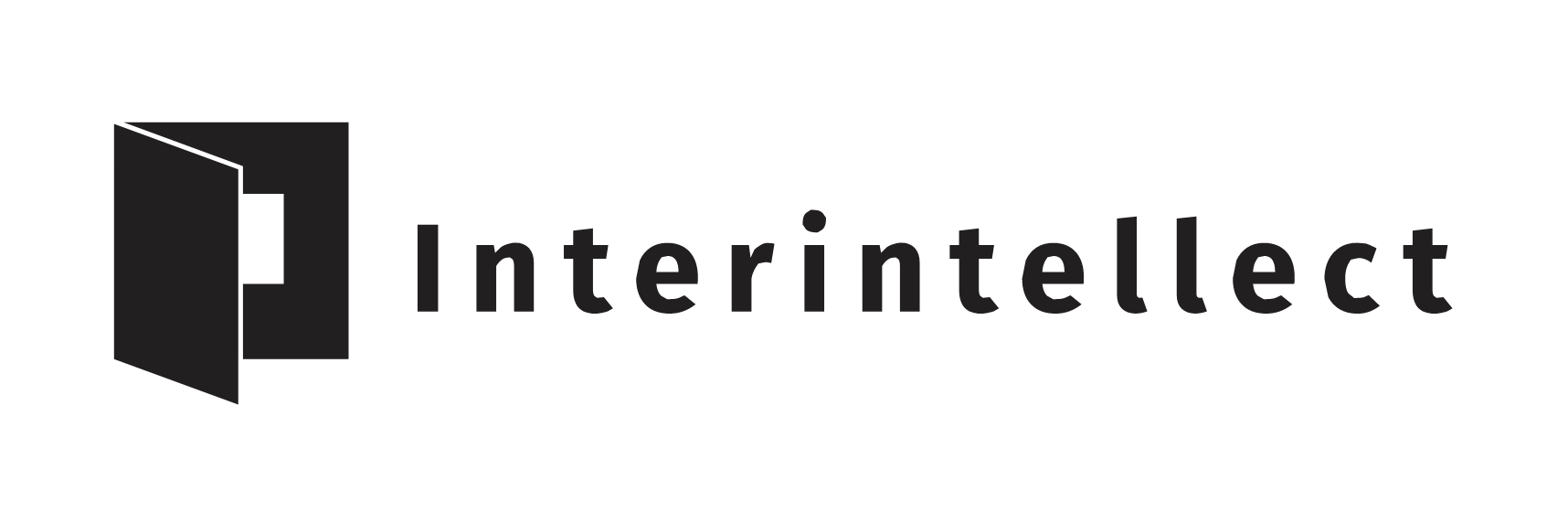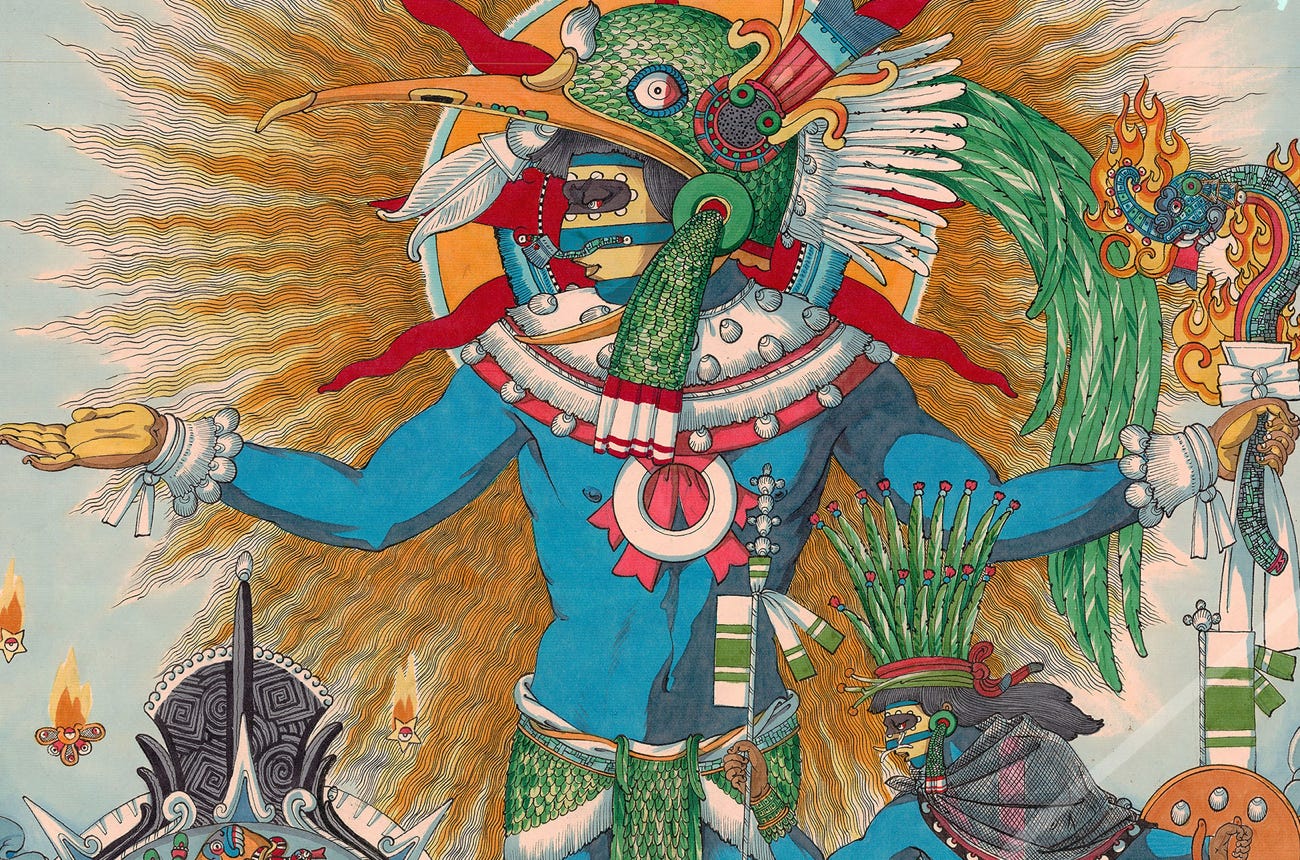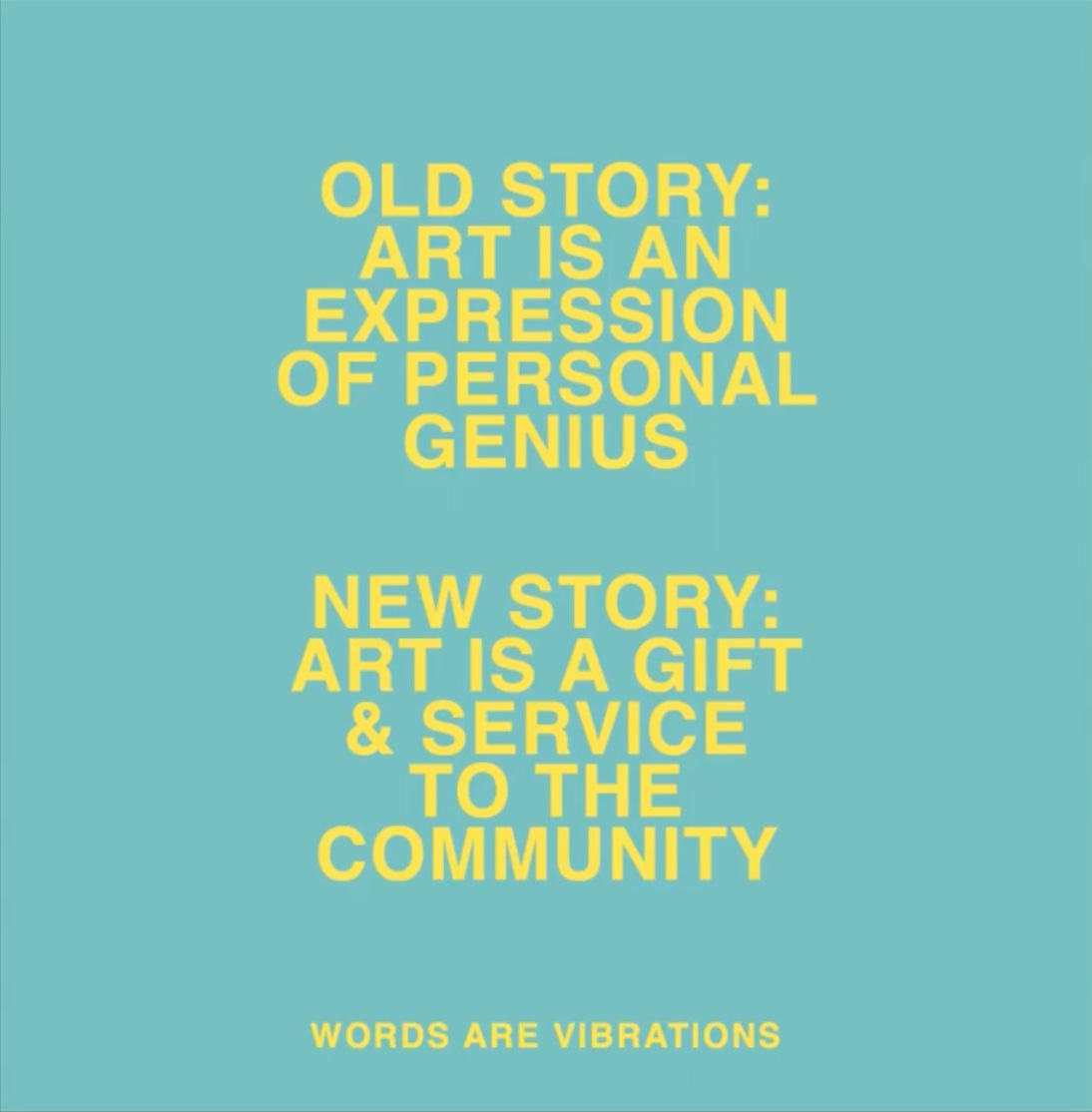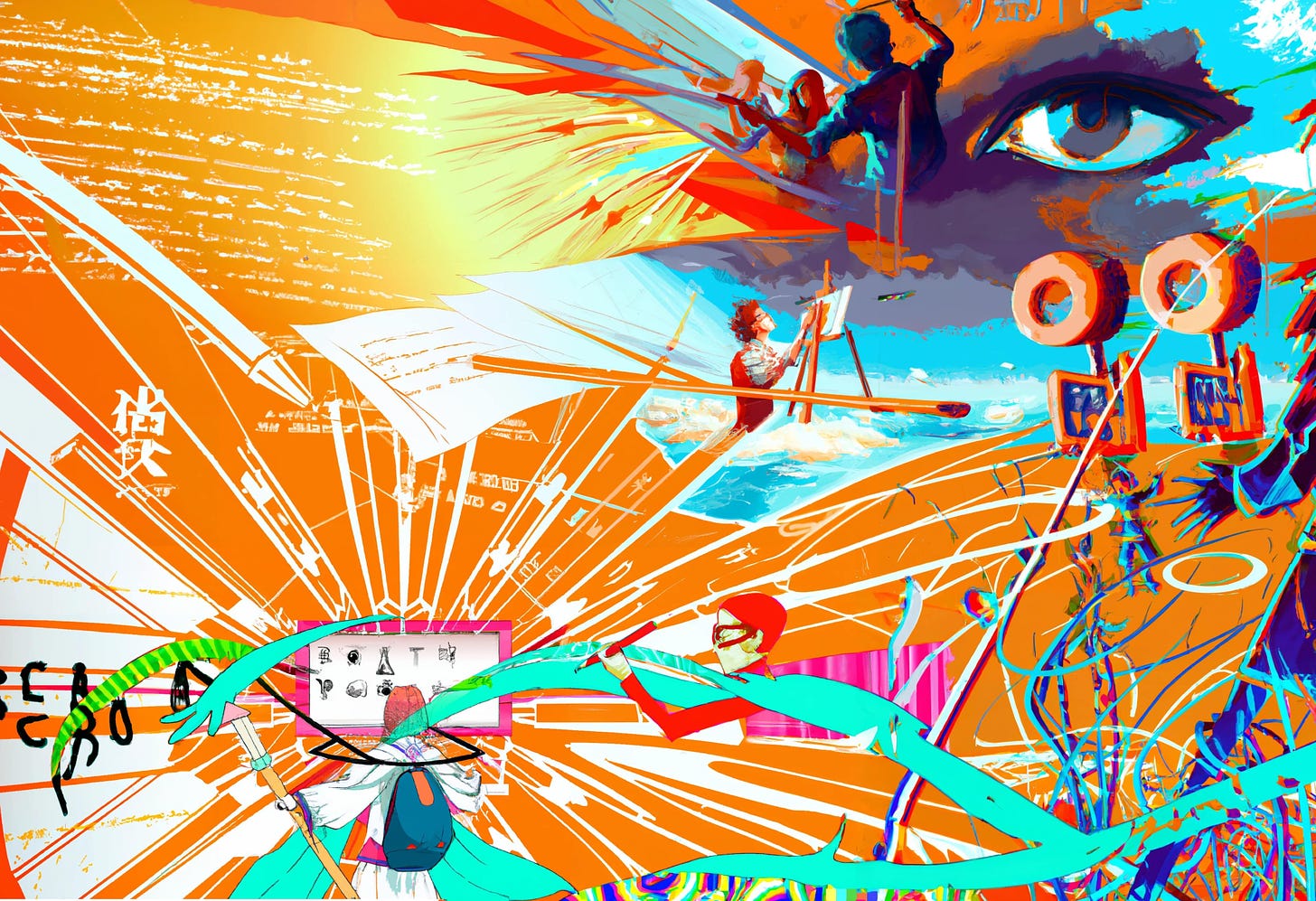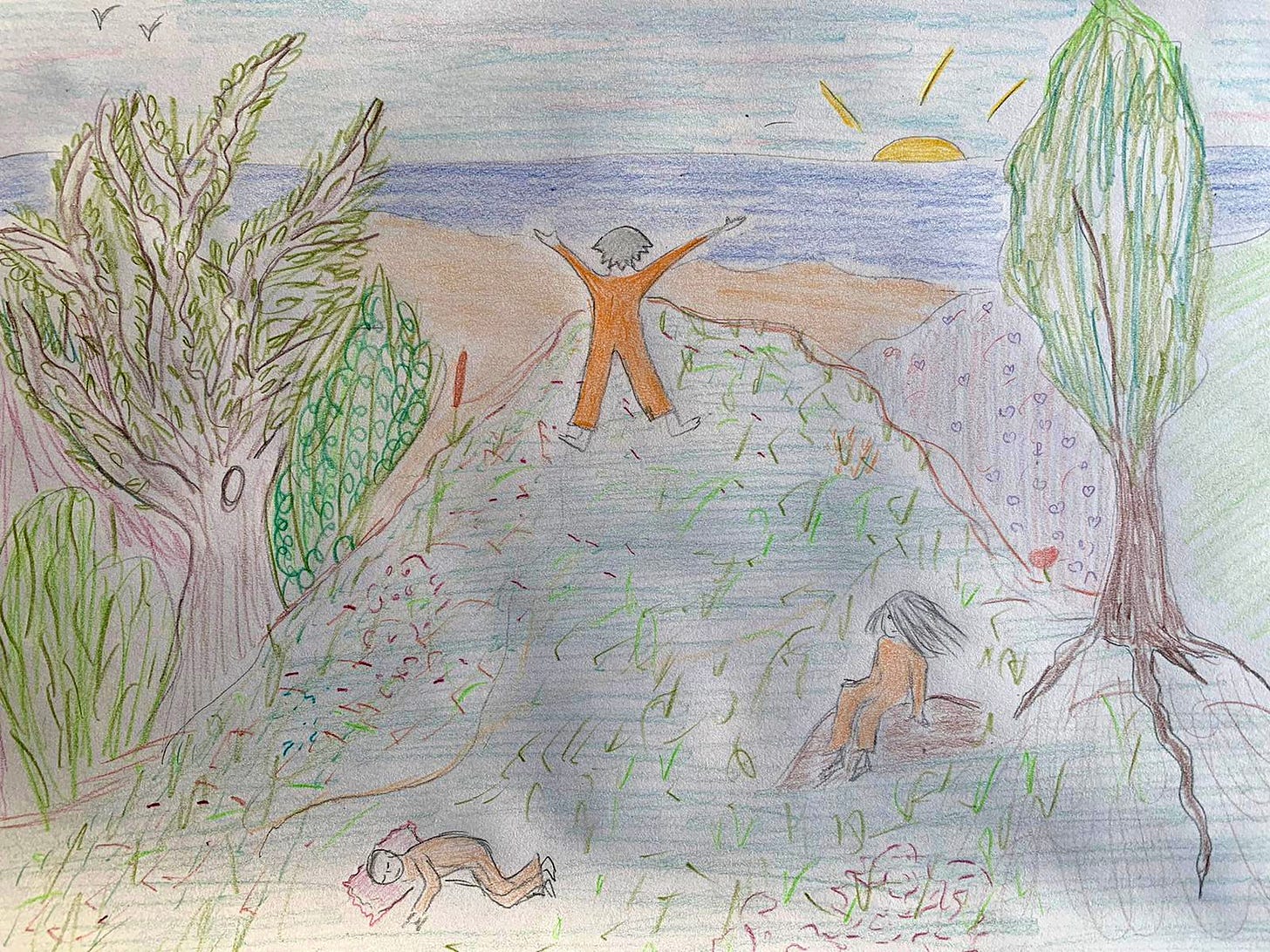Originally posted by Zelda on her substack, Tomorrow’s Ancestors
I had to step into the world of art to realize that creativity can happen in every moment.
Back then, I was studying dance at a professional level and I started to experience patterns between my life in the studio and outside of it. The creativity I’d call on while dancing was the same I’d use to make decisions in my day-to-day life; the grace necessary to master a step was the same I’d use to go through personal events harmoniously.
Although I didn’t end up pursuing a dance career, I kept the habit of experiencing life through a creative lens. As Rick Rubin titles his book, the creative act is a way of being.
I’d go a step further, highlighting that creativity is our natural way of being. We were built with 5 fingers to hold our tools, plenty of emotions to alchemize, a mind to transcend, and a soul to envision. Creativity isn’t something we need to learn, as George Land’s study suggests: 98% of kids aged 4-5 were found to be “creative geniuses” according to a test initially meant to measure NASA engineers’ creativity. We were made to make stuff.
Not only is this embedded in the human self, it’s also the law of our environment. Nature has perpetually transformed itself, producing new forms of life, destroying them to make space for other things to emerge, creating intricate patterns (think snowflakes), and inspiring us in everything from art and literature to technological innovation.
This sounds exciting. So why are we here, now? Why has humanity grown into a nihilist, apathetic, rigid state? What can the creative process teach us about what’s missing in the world, to start making progress again? How are we making the future happen?
Born dreamers, planners and builders
A creative process is provoked by a necessity for change, even if that starts just as a desire for it. Here, the dream shapes itself. There’s an idea. A new perspective on reality. A “What if?”, whether conscious or not.
Our ability to dream is the seed that gives birth to any great artwork, scientific discovery, social progress, company, or new habit in our daily lives. At this point, we need to believe that anything is possible in order to be really innovative (see divergent thinking).
Then comes the plan. Sketches, organizing our time, energy, and any other resource needed, are a must to see our vision come to life. The direction is set. This now requires convergent thinking, or the capacity to focus on finding a solution to a problem.
Finally, we need to activate our force of will to lead us to the execution of the aforesaid act. “Just do it”. The volume of grit (the sum of your passion and your perseverance) needed will depend on the size of the challenge. This is the final act of the process: the switch between a known past and an unpredictable future.
The “Dream, Plan, Build” cycle is present at every scale: it is observable when you decide to take a new road to go to work, as much as when you start developing your startup.
So far so good: except for some reason we killed the dreamers and demonized the builders.

A fragile world: how we let the planners rule our lives
Like when people say that no matter our gender we all hold masculine and feminine energy inside of us, I believe we all have a bit of the dreamer, planner and builder essence within us. But for most of us a particular yin or yang energy will dominate, and we often identify with one of these three crafts more than the other two.
By seeking the comfort of stability, humans came to more highly value the planner within us, pushing the “planner-driven” people to the top of our social hierarchies. And although foresight helped us free time for progress, it led us to a world designed and ruled by such rigid systems that it’s now a disservice to humanity.
While this was happening, dreamers were depicted as lazy, marginal figures, and builders as thieves and crooks.
The planner, when overworked, becomes the overthinker, the assumption maker, the pessimist, only seeing the reasons why we can’t make something.
In the same way, a dreamer- or builder-led world wouldn’t be desirable. For instance, when we build without a thoughtful dream or plan, we can end up creating things like the “endless scroll”, i.e. something that goes against our individual and collective wellness.
We can’t cut through the 3-step cycle of nature without paying a terrible cost.
change + creativity (dream + plan + build) = progress;
change + resistance = disaster
Change is the trigger that hopefully leads to a creative act, resulting in the transformation of ourselves and/or our environment.
But remember, we’re in the arc where humanity has traded progress for a false sense of control. The result? Nassim Taleb speaks about it better than anyone else: the world on an individual & collective level has become profoundly fragile.
By planning against the effects of our ever-changing world and selves, we’re manufacturing collective catastrophes (Taleb calls them Black Swans) and making ourselves sick (e.g. PTSD, the incapacity to grow out of a traumatic event). Of course, the disconnect from this natural principle is also what’s leading us to an ecological crisis.
The creative act is an answer to a need for change coming from our inner or outer environment. Denying that need is like playing life in auto-destruct mode.
About art: a misguided gatekeeping of creativity
By associating creativity with technical art-making, we took away people’s potential to use it to solve mundane problems. This results in people not being at all equipped to face the even harder ones.
My experience with dance showed me that art is a great way to rehearse your life, as a playground for testing and developing new perspectives. But this is not a must, nor does it require technical artistic skills. Art Brut, or Outsider Art, is a whole movement dedicated to this philosophy: it emphasizes art made by people trying to conquer their mental illness or expressing a reality academic artists weren’t interested in. The point wasn’t to make something beautiful, but for the maker to benefit from the creative process and envision a better fate.
The way into the future
We shouldn’t look to the past to draw conclusions about the future (that would make us too much of “planners”), but lindy phenomena can give us some inspiration. In this case, see how creativity has been the force of progress throughout the history of humanity:
Musical innovation is full of danger to the State, for when modes of music change, the fundamental laws of the State always change with them.” Plato
Artists to my mind are the real architects of change, and not the political legislators who implement change after the fact.” William Burroughs
Millennia after millennia, visionaries stated the big changes for humanity to undergo. They wrote myths and created art that made us believe in an optimistic future.
If politicians are the planners, artists are the dreamers. We need them to pull us into the future, thanks to imagination.
Only then will change feel irresistible.
Defining the collective quest ← ←
Let’s posit that the last big collective quest undertaken by humanity was the creation of the internet and the personal computer. What new paradigms did that allow for? For the first time in history, knowledge went from being restricted, with a relative few both accessing and making it, to becoming a commodity.
For the greatness of the challenge we’re facing, we better have lots of dreamers to show us the way. That means we need creativity to become a commodity as knowledge did before.
What kind of revolutionary invention do we need, with the potential of making an impact as large as the internet, in order to bring creativity to anyone and everyone?
¡¡¡A NEW EDUCATIONAL SYSTEM!!!
The beauty of thinking of education as our next quest is its universality. It knows no frontier, no ethnicity, no gender. Everyone has been a child. Everyone has an emotional response attached to the topic.
Today’s school pushes us away from our innate creativity. You know the funny thing about that? We are so obsessed with educating our kids that we don’t even notice what they can teach us. Children are incredibly antifragile and creative because change is an obvious constant for them. Imagine, you spend 9 months in the dark, surrounded by liquid, and from one moment to the other, you need to learn to breathe with your nose and deal with a world that overwhelms all your senses. Imagine having to grow your first teeth and learning how to chew. Imagine having your first menstrual cycle or having hair start to grow all over your body.

We must design school in our children’s image, not the other way around.
What does that look like? That’s what I invite us all to think about. With Tomorrow’s School, I involve individuals from all backgrounds and ages to become the leaders of this collective quest. They envision what the future of education should look like and make artwork about it. Then I spread their art to inspire others to dream about this common future. Here are some examples of contributions I’ve received:
I also received many poems, videos, AI generated art… you can discover them and learn more about their creators on my Instagram or website.
The trigger for a new school system is obvious: humans are in a crisis.
Step 1: have people dream. Only by making enough of them want it will planning and building follow naturally.
If you’ve read this far, you might think, “I love the brain of this girl, but I have no clue what this concretely means for my input for this new world???”
Some ideas:
- Deconstruct the belief that daydreaming = lazy. Replace it by practicing imagining an optimistic future. Kind of like meditation!
- Make art even if it’s ugly (learn to enjoy what you rehearse about your life).
- Study nature’s cycles and creative acts because they are a reflection of your own capacities.
- Notice your environment forcing changes within you. A person who’s late to your meeting. A flight that gets canceled. Your favorite drink’s out of stock. Celebrate and find a creative response these changes.
- When we work as a community, we can enrich on each other’s insights and make something greater. Develop your social ties.
- Contribute to Tomorrow’s School! Send me an artwork about your vision of education (here’s how), come to my workshops to learn about creativity, or help me answer these questions:
– Imagine Tomorrow’s School like a marketplace of visions for the future of education. We need volume to make it interesting. How to make Tomorrow’s School viral?
– How can we best display the artworks? Should I put them in a metaverse (like this)? Should I bring them to an art gallery? Should I make big collages in the streets with them (kinda like JR, here)?
– How can we bring Tomorrow’s School to more children and teens? Do you know any educators who would be interested in bringing the project into their classrooms? Or organizations working with this age range?
→ Write me if you have ideas or want to get involved in any way! zeldapoem@gmail.com
Frens, the next age for humanity is so incredibly exciting. Thanks for reading.

Cover image: Huitzilopochtli symbolizes the essence of willpower – by Chicome Itzcuintli Amatlapalli
I wouldn’t have birthed this essay without the incredible work of:
- James McRae, aka Words Are Vibrations, his art & workshops
- Reggie James, his talk with Eugene Angelo “Why Mars Needs a Creative Director” & essays
- Anna Halprin, the founder of the “Life/Art Process” creative principles that I studied in her institute
- Kyle Hall, and his thoughtful suggestions & corrections to my essays
- My grandmother and friend María Islas, who both helped me love myself and the world deeply
